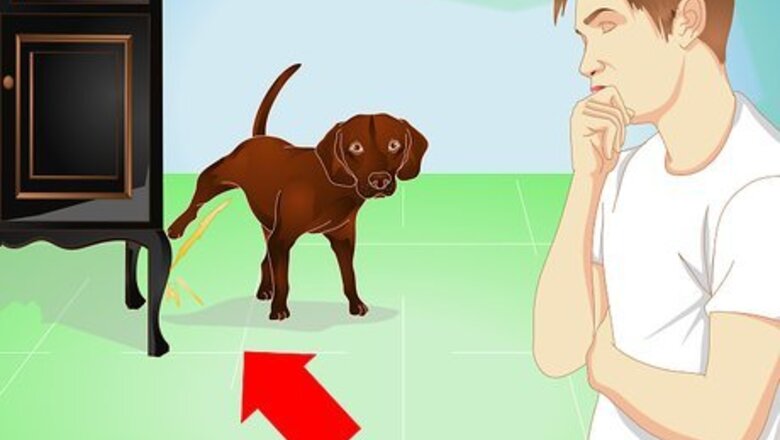
views
Understanding Why Your Dog Eliminates Inside

Be aware that there are many reasons why adult dogs may eliminate inside the house. Unlike puppies who just don’t know how to ask to go outside when they need to go, an adult dog may have much more complicated reasons for why it eliminates inside the house. If you have recently adopted an adult dog or you want to retrain your adult dog, you should first take some time to consider the reason(s) why your dog may be eliminating inside your home. Taking time to figure out what is going on with your dog will help you to decide on the best course of action.

Take your dog to a veterinarian to rule out medical issues. Before you try to housebreak your adult dog, you should take him to the veterinarian to have a check-up. Some adult dogs begin to have problems with elimination due to medical issues. Your veterinarian can assess your dog to see if a medical condition is causing him to urinate or defecate inside the house. Common medical conditions that may lead to problems with your dog eliminating in the house include: Changes in your dog’s diet Gastrointestinal issues Urinary tract infection Bladder stones Post-spaying hormone issues in female dogs Medications Arthritis Age related cognitive dysfunction
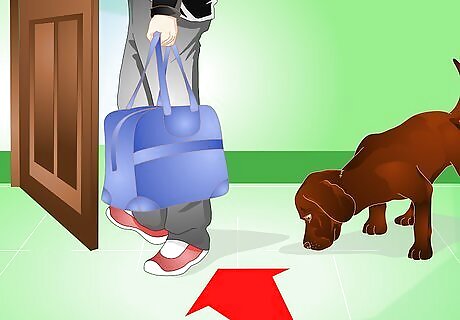
Consider recent subtractions and/or additions your home. Some dogs develop problems with eliminating inside the house because a beloved family member has left the home or because someone has been added to the home. Consider the recent departures and arrivals in your family to determine if this may be the cause of your dog’s elimination problems. Did one of your children recently go off to college? Or did you recently get a new puppy? If a recent change is the cause of your dog’s elimination problems, it may take time for your dog to get used to the new family situation. Be patient and do things to let your dog know hat he is still valued and loved despite the changes. Play with him, give him praise, toys, and treats to help him feel more secure.
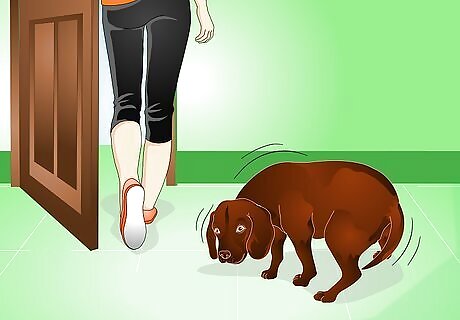
Determine if fear or anxiety may be causing your dog’s problems. Some dogs develop fear or anxiety about going outside and may begin eliminating in the house as a result. If your dog seems reluctant to go outside, there may be something about the experience that is frightening to him. Try to determine what is causing your dog’s reluctance to eliminate outside. For example, if your dog is frightened by the sound of passing cars, he may end up not eliminating enough or at all when you take him out for a walk.
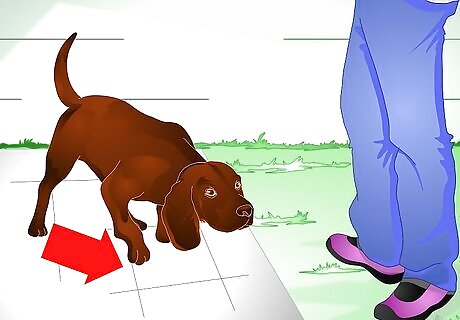
Identify any surface preferences that your dog has. Some dogs don’t like to go outside because they have developed a preference for a certain type of surface. Common surface preferences include carpet, concrete, and furniture. Identifying your dog's surface preference may be necessary in order to retrain him to go to the bathroom outside. Pay attention to where your dog goes to the bathroom most often. Does he prefer to go on the carpet, on the tile floor, on a pile of laundry, or somewhere else? Can you think of any reason why he might prefer that spot over going outside? A surface preference may be related to the dog’s previous environment. For example, a dog that spent the last few years living in an environment where he was seldom let outside may have developed a surface preference for carpet. Or, a dog that was raised in a laboratory may have a surface preference for concrete.
Housebreaking Your Adult Dog
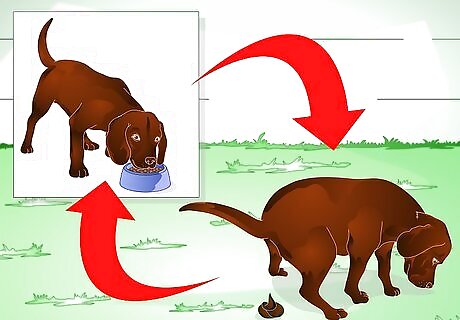
Develop a good daily routine. Having a solid daily routine may help your dog to stop eliminating inside the house. Make sure that you feed your dog at the same times every day and take your dog outside at the same times every day. Your dog should be allowed to go outside to eliminate at least four times per day. If your dog’s feeding and outside times have become erratic, decide on a schedule that will work for you and stick to it. A sample schedule for feeding and taking your dog out might be something like: 6:00am: let Fido outside 7:00am: feed Fido breakfast 7:30am: let Fido outside 12:00pm: let Fido outside 5:00pm: take Fido for a walk 7:00pm: feed Fido dinner 7:30pm: let Fido outside
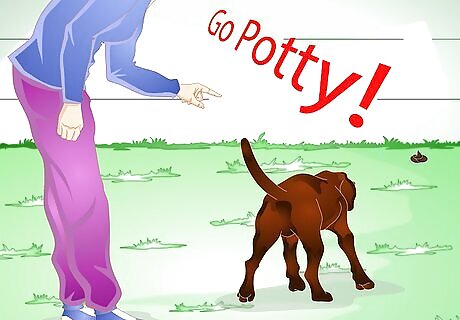
Encourage your dog to use the same spot every time you take him outside. In addition to keeping a steady routine for taking your dog outside, taking him to the same spot every time may also help you to housebreak your dog. Use an encouraging phrase such as “go potty” to let your dog know what you want him to do when you get to that spot. The repetition of going to the same place and hearing the same words will help your dog understand what you want from him. Remember to offer your dog lots of praise after he goes to the bathroom outside.
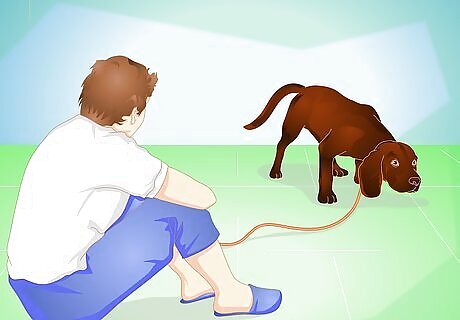
Monitor your dog at all times. Watching your dog for signs that he might be about to urinate or defecate in the house can help you to housebreak him. If your dog is prone to eliminating inside the house, find a way to keep him in your sight at all times. Monitoring your dog’s whereabouts will help you to prevent him from eliminating inside the house. Try keeping your dog on a six foot long leash that is attached to you. This will prevent him from going off to another room to eliminate and it will also help you to observe his behavior and determine when he needs to go. If you cannot keep an eye on your dog during the day, you can use a crate or baby gate to confine your dog to a small area for short periods of time (less than 4 hours).
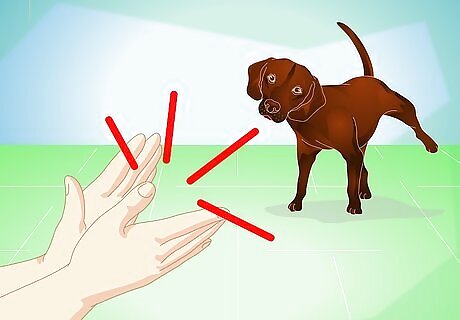
Stop your dog from eliminating inside the house by clapping. As soon as you notice that your dog is getting ready to urinate or defecate, get his attention by clapping your hands together loudly. Do not yell at your dog or use physical punishment to change his behavior. Just clap your hands to get his attention and then lead or carry him outside right away. Be kind and encouraging to your dog as you lead him outside. If you yell or act like you are angry with him, he may begin to associate going outside with punishment.
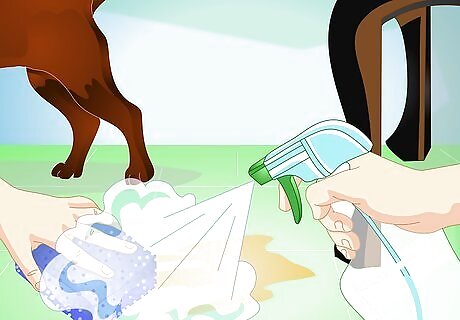
Clean up messes as soon as they happen. The smell of a prior mess can prompt your dog to want to eliminate in the same place again. The best way to prevent your dog from soiling an area again is to clean up his messes right away by using an enzymatic cleaner made especially for cleaning up pet messes. Don’t yell or punish your dog for going inside the house. It will not do anything to discourage him and it may even lead to more accidents by increasing his fear and anxiety.

Praise your dog when he eliminates outside. Positive reinforcement is the best way to teach your dog a new behavior. Make sure that you reward your dog with lots of praise after he urinates or defecates outside. You can also reward your dog for eliminating outside by giving him treats, playtime, or a walk.
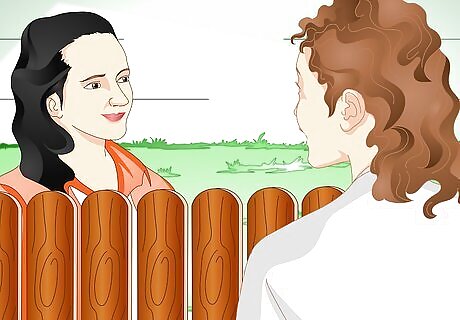
Ask a neighbor or friend to take your dog outside when you will be gone for long periods. To make sure that your dog does not have to hold it for long periods of time, ask a friend or neighbor to come by and take your dog out for you if you will be gone for a long period of time. Forcing your dog to stay in the house for several hours will lead to eliminating inside the house because he will not be able to hold it for that long. If you don’t know anyone who is willing or able to take your dog out for you during long periods away, consider hiring a pet sitter to stop by.
Using Other Strategies to Housebreak Your Adult Dog
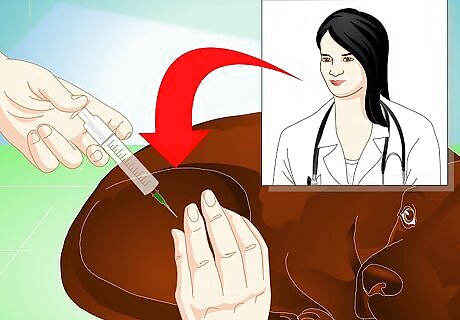
Follow your veterinarian’s instructions for treating any medical issues. If your veterinarian has identified a medical condition that requires special treatment, medication, or other interventions, make sure that you follow the veterinarian’s instructions. If your dog’s elimination problems are related to a medical condition, they will not improve until he is cured. Contact your veterinarian immediately if your dog’s condition worsens or does not improve despite treatment.
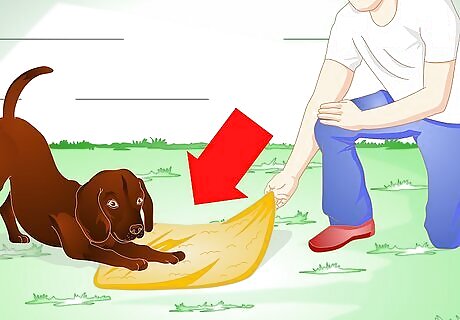
Work to change your dog’s surface preference to grass. You can get your dog to stop eliminating inside the house by gradually introducing grass to the type of surface your dog prefers to use. For example, if your dog prefers to urinate on carpet, place a piece of carpet or a small rug in your back yard. Allow your dog to use the rug, but add a handful of grass to the carpet every day. When the carpet is completely covered in grass and your dog is still using it, remove the carpet. Your dog should be used to using a grassy surface and continue eliminating on the grass.
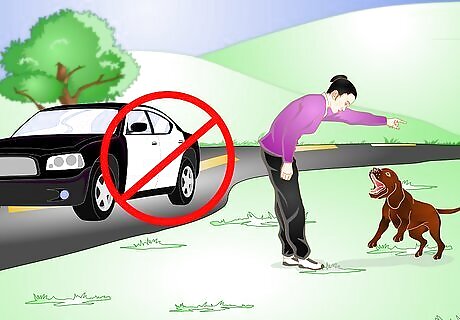
Ease your dog’s fear and anxiety about going outside. Simple changes to your daily routine or to your dog’s environment may help to ease some of his fears and anxieties. After you have identified the source of your dog’s fear, you can take steps to try to eliminate or reduce it. For example, if your dog is frightened by the sound of passing cars when you take him out for a walk, try taking a quieter route or taking your walk at a time of day when there is less traffic.
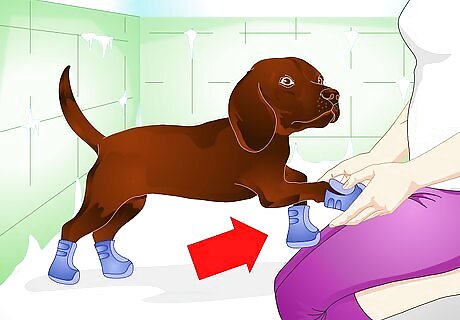
Consider getting cold and/or wet weather gear for your dog. Some dogs just don’t like to go outside when the weather is bad. You can help make the experience more tolerable for your dog by getting cold and/or wet weather gear for your dog. For example, if your dog does not like the feel of his paws in the snow, consider getting some boots for your dog to wear when you take him outside. Or, if your dog doesn’t like to get wet, consider getting him a raincoat to wear when it is raining.
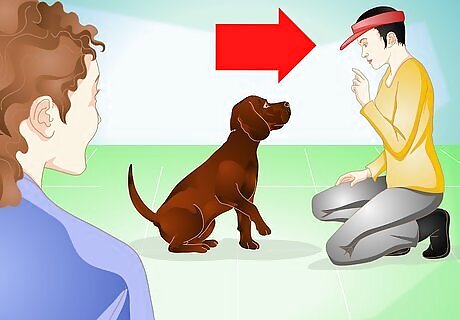
Consider getting help from a certified professional dog trainer. Some dogs have multiple reasons for why they are not housebroken or why they begin eliminating in the house after years of going outside. If your dog does not respond to your housebreaking efforts and there is no medical reason for your dog’s issues, you may want to consider hiring a certified professional dog trainer to help you housebreak your adult dog.


















Comments
0 comment